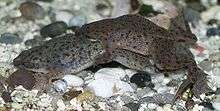Pipidae
The Pipidae are a family of primitive, tongueless frogs. The 41 species in the family Pipidae are found in tropical South America (genus Pipa) and sub-Saharan Africa (the three other genera).
| Pipidae | |
|---|---|
 | |
| African dwarf frog | |
| Scientific classification | |
| Kingdom: | Animalia |
| Phylum: | Chordata |
| Class: | Amphibia |
| Order: | Anura |
| Clade: | Pipoidea |
| Clade: | Pipimorpha |
| Family: | Pipidae Gray 1825 |
 | |
| Distribution of Pipidae in black | |
Description
Pipid frogs are highly aquatic and have numerous morphological modifications befitting their habitat. For example, the feet are completely webbed, the body is flattened, and a lateral line system is present in adults.[1] In addition, pipids possess highly modified ears for producing and receiving sound under water. They lack a tongue or vocal cords, instead having bony rods in the larynx that help produce sound. They range from 4 to 19 cm (1.6 to 7.5 in) in body length.[2]
Extant genera
Family Pipidae Gray 1825[3]
- Hymenochirus Boulenger 1896 - dwarf clawed frogs (4 species)
- Pipa Laurenti 1768 - Surinam toads (7 species)
- Pseudhymenochirus Chabanaud 1920 - Merlin's dwarf gray frog or Merlin's clawed frog (1 species)
- Xenopus Wagler 1827 - clawed frogs (29 species)[4]
Fossil record
The fossil record for pipids and close relatives (Pipimorpha) is relatively good, with several extinct species known.[5] Six of these are placed in the extant genus Xenopus, the remainder in extinct genera. These fossils are known from Africa, South America, and the Middle East back to the Lower Cretaceous.[2][5]
Fossil Pipidae
- South America
| Ma | Age | Taxon bold is n. sp. | Formation | Basin | Country | Refs |
|---|---|---|---|---|---|---|
| 84 | Campanian | cf. Xenopus sp. | Los Alamitos | Neuquén | Argentina | [6] |
| 61.9 | Peligran | ?Pipidae indet. | Hansen Mb, Salamanca | Golfo San Jorge | Argentina | [7] |
| 54.69 | Riochican | Llankibatrachus truebae | Huitrera | Neuquén | Argentina | [8] |
| 53 | Itaboraian | Xenopus romeri | Itaboraí | Itaboraí | Brazil | [9] |
| 52.44 | Casamayoran | Shelania pascuali | Laguna del Hunco | Cañadón Asfalto | Argentina | [10] |
| 45 | Mustersan | ?Pipidae indet. | Pozo | Ucayali | Peru | [11] |
| 11.8 | Mayoan-Huayquerian | cf. Pipa sp. | Urumaco | Falcón Basin | Venezuela | [12] |
References
- "AmphibiaWeb: Pipidae". Berkeley, California: AmphibiaWeb. Retrieved 2009-10-25.
- Zweifel, Richard G. (1998). Cogger, H.G.; Zweifel, R.G. (eds.). Encyclopedia of Reptiles and Amphibians. San Diego: Academic Press. pp. 86–87. ISBN 0-12-178560-2.
- Pipidae at the Amphibian Species of the World 6.0 - AMNH
- Evans et al., 2015
- Gómez, 2016
- Báez, 1987
- Gelfo et al., 2007
- Báez & Pugener, 2003
- Estes & Wake, 1972
- Báez & Trueb, 1997
- Antoine et al., 2016
- Head et al., 2006
Bibliography
- Gómez, Raúl O. 2016. A new pipid frog from the Upper Cretaceous of Patagonia and early evolution of crown-group Pipidae. Cretaceous Research 62. 52–64. doi:10.1016/j.cretres.2016.02.006
- Antoine, P.; J.A. Abello; S. Adnet; A.J. Altamirano Sierra; P. Baby; G. Billet; M. Boivin; Y. Calderón, and A.R. Candela and J. Chabain, F. Corfu, D. A. Croft, M. Ganerød, C. Jaramillo, S. Klaus, L. Marivaux, R. E. Navarrete, M. J. Orliac, F. Parra, M. E. Pérez, F. Pujos, J. Rage, Anthony Ravel, Céline Robinet, Martin Roddaz, Julia Victoria Tejada Lara, Jorge Vélez-Juarbe, Frank P. Wesselingh and Rodolfo Salas Gismondi. 2016. A 60-million-year Cenozoic history of western Amazonian ecosystems in Contamana, eastern Peru. Gondwana Research 31. 30–59. Accessed 2020-03-19.
- Ben J. Evans, et al. 2015. Genetics, morphology, advertisement calls, and historical records distinguish six new polyploid species of African Clawed Frog (Xenopus, Pipidae) from West and Central Africa. PLoS One 10. 1–51. Accessed 2020-03-19.
- Gelfo, J.N.; E. Ortiz Jaureguizar, and G.W. Rougier. 2007. New remains and species of the 'condylarth' genus Escribania (Mammalia: Didolodontidae) from the Palaeocene of Patagonia, Argentina. Earth and Environmental Science Transactions of the Royal Society of Edinburgh 98. 127–138. Accessed 2020-03-19.
- Head, Jason J.; Marcelo R. Sánchez Villagra, and Orangel Aguilera. 2006. Fossil snakes from the Neogene of Venezuela (Falcon State). Journal of Systematic Palaeontology 4. 233–240. Accessed 2020-03-19.
- Gissi, Carmela; Diego San Mauro; Graziano Pesole, and Rafael Zardoya. 2006. Mitochondrial phylogeny of Anura (Amphibia): A case study of congruent phylogenetic reconstruction using amino acid and nucleotide characters. Gene 366. 228–237. PMID 16307849 doi:10.1016/j.gene.2005.07.034
- Roelants, Kim, and Franky Bossuyt. 2005. Archaeobatrachian paraphyly and pangaean diversification of crown-group frogs. Systematic Biology 54. 111–126. doi:10.1080/10635150590905894 PMID 15805014
- San Mauro, Diego; Miguel Vences; Marina Alcobendas; Zardoya Rafael, and Axel Meyer. 2005. Initial diversification of living amphibians predated the breakup of Pangaea. American Naturalist 165. 590–599. Accessed 2020-03-19. doi:10.1086/429523 PMID 15795855
- Báez, A.M., and L.A. Pugener. 2003. Ontogeny of a new Palaeogene pipid frog from southern South America and xenopodinomorph evolution. Zoological Journal of the Linnean Society 139. 439–476. Accessed 2020-03-19.
- Báez, A.M., and L. Trueb. 1997. Redescription of the Paleogene Shelania pascuali from Patagonia and its bearing on the relationships of fossil and Recent pipoid frogs. Scientific Papers, Natural History Museum, University of Kansas 4. 1–41. Accessed 2019-03-01.
- A.M. Baez, A.M. 1987. The Late Cretaceous fauna of Los Alamitos, Patagonia, Argentina part III — anurans. Revista del Museo Argentina de Ciencias Naturales "Bernardino Rivadavia" e Instituto Nacional de Investigacion de las Ciencias Naturales: Paleontología 3. 121–130. Accessed 2020-03-19.
- Estes, R., and M.H. Wake. 1972. The first fossil record of caecilian amphibians. Nature 239. 228-231.
